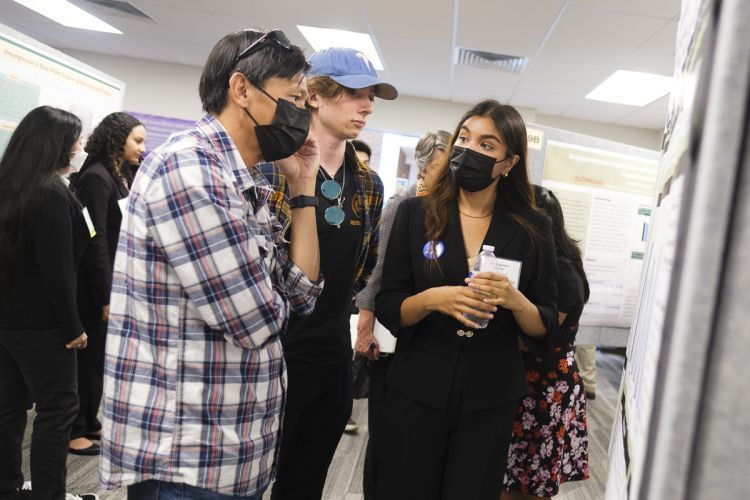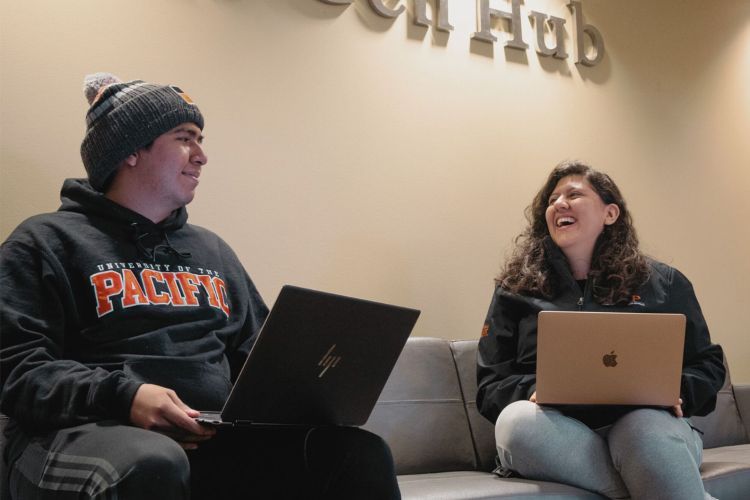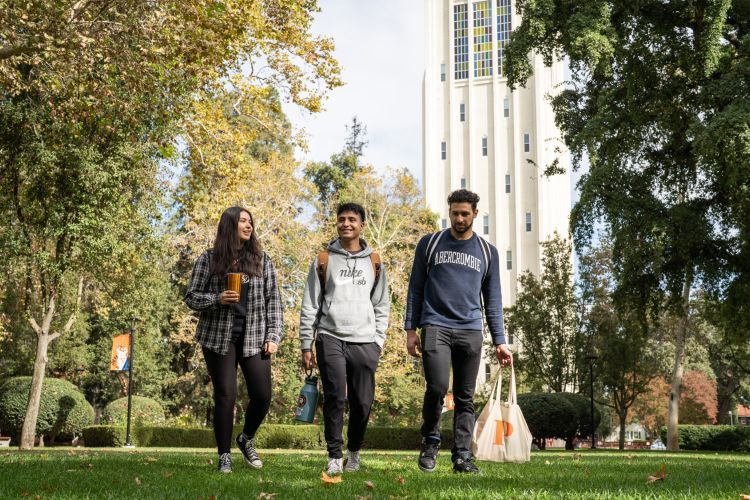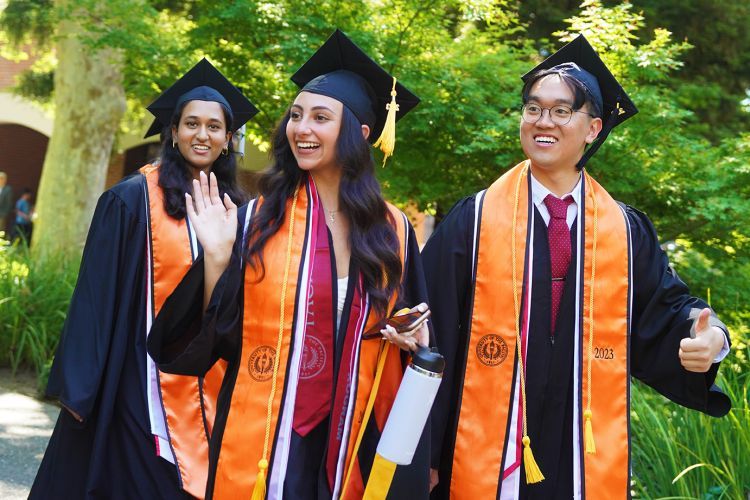Breadcrumb
Students, faculty showcase wide array of research efforts

Psychology major Ana Anguiano presents her research on the effectiveness of gardening therapy at the annual Pacific Undergraduate Research and Creativity Conference.
A wide range of topics—from rising real estate prices to microplastics in food—were among the more than 100 areas explored by faculty and students at University of the Pacific’s Research Day April 30.
The annual event, held in the newly modernized William Knox Holt Memorial Library and Learning Center, included oral and poster presentations by undergraduate and graduate students and faculty members surrounded by curious observers.
The experience conducting original research provides students an unparalleled opportunity to pursue areas of interest guided by expert faculty.
“Most of my experience before this was doing papers and research for classes,” said music history major Molly Westlake, ’22, who worked on a research project on Black opera. “Being able to devise this whole project, plan it out and work on it for so long alongside my mentor was special. It was great to have that experience conducting a longer-length research project.”
“For students, closing the loop on the research project by telling others what they did is so important,” said Lydia Fox, director of undergraduate research. “They get really excited about doing these presentations.”
Some of the research presentations included:
The history of Black opera
As a recipient of Pacific’s Summer Undergraduate Research Fellowship, Westlake ’22 took exploring the history of Black opera from Pacific’s archives to New York.
The fellowship funding allowed her to watch a Black-composed opera, “Fire Shut Up in My Bones,” performed at the Metropolitan Opera House for the first time in its 141-year history.
“The performance was absolutely amazing,” said Westlake. “The music, the plot and the staging are all important to research about the actual work and you can’t really know unless you’re able to see it.”
Black operas have historically been relegated to smaller opera companies and Black singers have either struggled to be included in casting or performed stereotyped roles.
“One of the biggest takeaways is how much music out there is composed by underrepresented or unknown composers,” said Westlake. “We have the music and the manuscripts, but it's just not researched, or has never been performed or recorded, so there's a lot of work to do in this field.”
Microplastics in food and personal-care packaging products
The growing concern over the discovery of microplastics—tiny pieces of plastic in the environment, food and other products—sparked Mandy-Tanity Brinkmann’s interest.
“In general, the literature on microplastics research is all very new,” said the first-year pharmaceutical and chemical sciences doctoral student, adding that much of the research has focused on fish, salt and soil. “We wanted to look at other items.”
Along with biochemistry major Huy Ngoc Nguyen and biology major Daniel Hui, Brinkmann used special techniques in one of Pacific’s labs to determine if they could find microplastics in yogurt and facial creams.
Though their initial methods were inconclusive, they did find another surprising substance in a sample of yogurt, called microcrystalline cellulose.
“It was a very interesting finding. I did research into microcrystalline cellulose, and it turns out that a lot of food production companies add it as a filler so there’s more product at the end, but it's not declared in the ingredient list,” said Brinkmann.
She identified other methods that may be more useful for testing future samples for microplastics.
“A lot of research groups use pyrolysis-gas chromatography-mass spectrometry (a type of chemical analysis) to identify and also quantify microplastics, and it's really the next step we're excited to do,” said Brinkmann.
Effectiveness of gardening therapy
As a member of Pacific’s #CaliforniansForAll College Corps, a program that helps students pay for college by performing high-impact community service, psychology major Ana Anguiano’s research was inspired by her experience with Stockton-based nonprofit PUENTES.
“They work to combat food insecurity and food deserts by providing people with gardens free of charge,” explained Anguiano.
Anguiano surveyed students, military veterans and people diagnosed with anxiety and depression to determine if gardening could be beneficial in improving mental health.
“All of the participants reported it improved their mental health,” said Anguiano. “It’s gratifying to see that something as simple as gardening could improve people's mental health because psychotherapy and medications can be expensive and not feasible for every single person.”
Science identity and self-efficacy in STEM fields
Eberhardt School of Business Professors Jeffrey Miles and Stefanie Naumann surveyed nearly 1,000 students to learn what can be done to encourage people who do not identify as male or heterosexual to enter STEM fields (Science, Technology, Engineering and Math.)
In 2019, women only had 27% of STEM jobs despite making up nearly half the workforce, according to the U.S. Census. Though there is little research, there appears to be a similar gap among gay men.
“We want to make sure that everyone feels interested and excited about going into STEM fields, regardless of their gender identity or sexual orientation,” said Miles.
Their study determined women had lower levels of science self-efficacy and science identity than men.
“We found that we can improve people's self-perceptions that they’re able and efficient and effective to be a scientist so they will pursue STEM fields,” Miles said.
Miles said they plan to expand their research. “One of the challenges was to get data on people's identity and gender perceptions. Future research should look at all the gender ranges as well as sexual orientations.”
View research presented at this year’s Research Day.





